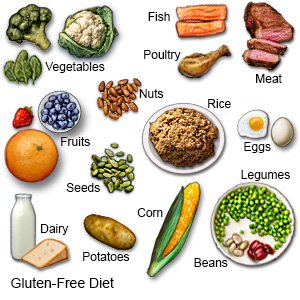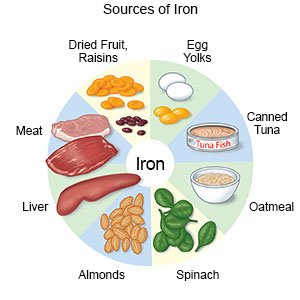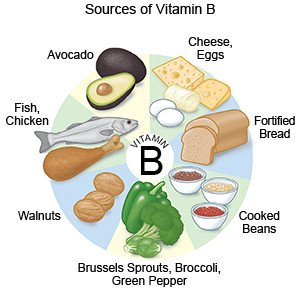Gluten-Free Diet
Medically reviewed by Drugs.com. Last updated on Aug 4, 2025.
What is a gluten-free diet?
A gluten-free diet is a meal plan that does not contain any gluten. Gluten is a protein found in wheat, rye, and barley. Gluten is found in many breads, pastas, cereals, cakes, pies, and cookies. Some vitamin supplements and medicines may also contain gluten. You need to follow this diet for the rest of your life if you have celiac disease, dermatitis herpetiformis, or non-celiac gluten sensitivity.
Which foods should I avoid?
Do not eat foods that contain the following ingredients:
- Barley, barley malt, barley extract, rye, bulgar, semolina, and triticale
- Wheat, wheat bran, wheat germ, and wheat starch
- Wheat varieties such as kamut and spelt
- Bran, couscous, durum, farina, and orzo
- Matzo flour, matzo meal, graham flour
- Oats that are not labeled as gluten-free, unless your dietitian has allowed you to eat a small amount
- Malt extract and malt flavoring
- Einkorn, emmer, faro, panko, seitan, and udon
Which foods can I have?
Choose foods labeled as gluten-free. You may be able to eat gluten-free oats, or you may be able to eat regular oats in small amounts. Ask your dietitian if oats are safe for you to eat. You may eat foods that are made with the following types of grains and starches:
- Corn, potato starch, and potato flour
- Soy, tapioca, and teff
- Rice, rice bran, quinoa, sago, and sorghum
- Amaranth, arrowroot, and buckwheat
- Flours made from nuts, beans, and seeds
- Flax, millet, and montina
Related medications
What are examples of gluten-free foods?
- Fresh fruits and vegetables
- Eggs, meat, fish, and poultry
- Dried beans, lentils, and peas
- Beverages such as 100% fruit juice, coffee, tea, cocoa, and soft drinks
- Fats and oils, such as butter, margarine, and vegetable, canola, and olive oils
- Regular, unflavored milk, cottage cheese, most yogurts, and aged cheese such as cheddar cheese
- Cream, sour cream, cream cheese, most ice creams, and sherbets
- Cream of rice, grits, puffed rice, brown rice, and white rice
- Corn tacos and tortillas
 |
What is a sample menu for 1 day?
- Breakfast: Soft boiled eggs, gluten-free toast with butter, and milk
- Morning snack: Gluten-free rice cakes or crackers
- Lunch: Tuna salad with tomato and lettuce, and an apple
- Afternoon snack: Carrot sticks
- Dinner: Broiled chicken, baked potato, green beans, and sorbet with strawberries
What can I do to make a gluten-free diet part of my lifestyle?
- Follow up with your healthcare provider or dietitian as directed. It may take time to learn how to properly follow a gluten-free diet. Your dietitian can help you find ways to fit this diet into your lifestyle.
- Learn to read food labels. Gluten is found in many foods and drinks. It may not be clear which foods contain gluten. Include a variety of allowed foods so that you can get all the nutrients you need.
- Prepare for restaurant meals. Carry a list of items allowed on this diet with you when you are away from home. Go to the restaurant's website or call ahead to find out if the restaurant has gluten-free meals. Tell the waitress that you cannot eat wheat, rye, or barley. Ask how food is prepared.
- Prepare gluten-free foods separately from other foods. Cross-contamination is when foods that contain gluten get mixed in with gluten-free foods. Prevent cross contamination by cleaning counter tops and cutting boards well to remove any crumbs that contain gluten. Wash cooking utensils, colanders, and pans well before you cook gluten-free foods. Buy a separate toaster to use for gluten-free breads. Buy separate jam, jelly, mayonnaise, or peanut butter to use on gluten-free breads to avoid cross contamination. These foods are also available in squeeze containers.
- Include naturally gluten-free foods that are high in iron, folate, and vitamin B12. Foods high in iron and vitamin B12 include meat, fish, poultry (chicken and fish), liver, and eggs. Foods high in folate include broccoli, asparagus, orange juice, legumes, peanuts, walnuts, and sunflower seeds.


- Ask your healthcare provider if you need a vitamin and mineral supplement. Celiac disease and dermatitis herpetiformis can damage your intestines. This damage can decrease the absorption of certain vitamins and minerals. Also, many gluten-free cereals, pastas, and breads are not fortified with vitamin B and iron.
When should I call my doctor or dietitian?
- You must take a medicine or vitamin that contains gluten.
- Signs and symptoms of your condition get worse.
- You are losing weight, without trying.
- You have questions or concerns about your condition or care.
Care Agreement
You have the right to help plan your care. Discuss treatment options with your healthcare provider to decide what care you want to receive. You always have the right to refuse treatment. The above information is an educational aid only. It is not intended as medical advice for individual conditions or treatments. Talk to your doctor, nurse or pharmacist before following any medical regimen to see if it is safe and effective for you.© Copyright Merative 2025 Information is for End User's use only and may not be sold, redistributed or otherwise used for commercial purposes.
Further information
Always consult your healthcare provider to ensure the information displayed on this page applies to your personal circumstances.
